The economic significance of pig farming is far-reaching and deeply rooted in the history of the United States economy. From creating millions of jobs to supplying a plethora of products, the pig farming industry has had an indelible impact on the US economy. This exploration into the economic impact of pig farming provides an insightful look into the historical context, the current state of the industry, its contributions to the economy, and the challenges it encounters. It also offers a future outlook, contemplating the potential changes and developments that might further shape this vital industry.

The History of Pig Farming in the US
Origins of Pig Farming in the U.S.
Pig farming in the United States has a history as old as the nation itself. British colonists introduced pigs to North America in the 16th and 17th centuries, utilizing them as a crucial source of food. These pigs were allowed to range freely, making efficient use of waste products and converting them into valuable meat. The importance of this practice increased with industrialization, as pigs cleaned up city streets before the invention of organized city waste removal.
Growth of the Pig Farming Industry
With the westward expansion in the 19th century, pig farming significantly grew in the Midwest, generating a flourishing pork packing industry in cities such as Cincinnati and Chicago. The advent of refrigerated rail cars in the latter half of the century further powered the industry by allowing pork to be shipped to larger markets more easily. Despite technological advancements, hog farming remained largely a small-scale, diversified family farm enterprise throughout much of the 19th and 20th centuries.
Industrialization of Pig Farming
The landscape of pig farming began to change dramatically in the late 20th century, moving away from traditional family farms towards large, industrialized operations. This transition was driven by several factors, including advancements in breeding and nutrition science, the development of new processing methods, and the transformation of food retailing. In addition, policy changes favored larger operations, leading to significant consolidation in the industry.
Current Status and Economic Impact of Pig Farming
Presently, the United States is the world’s leading pork exporter, with the pork industry contributing over $40 billion to the U.S. gross domestic product. As per data from the U.S. Department of Agriculture, the country had about 68.4 million hogs and pigs as of December 2020. The industry supports about 550,000 jobs nationwide. Iowa, North Carolina, and Minnesota are the top three hog producing states, contributing significantly to their local economies.
Pig Farming and Agricultural Economics
The economics of pig farming has a significant impact on U.S agricultural economics. The pig farming industry contributes by purchasing grain, which supports crop farmers, while also generating enormous sales of pork, domestically and internationally. In many regions, pig farming provides the only market for surplus grains, which is crucial for the economic sustainability of local grain farmers. Moreover, the pig farming industry has a strong multiplier effect, resulting in significantly more output and employment in the economy from every dollar of pork produced.
Environmental and Social Impacts
The shift towards industrialized pig farming has had significant environmental and social impacts, which come with economic costs. Large-scale farms generate a substantial amount of manure, which can lead to water contamination if not properly managed. Conversely, well-managed manure can be an economic benefit as a valuable source of organic fertilizer. Socially, industrial pig farming has been criticized for its impact on rural communities, with concerns that the wealth generated by these operations is not equitably distributed. These factors shape the economic and policy landscape of pig farming, influencing its future course.
Post-Pandemic Economic Dynamics of Pig Farming
The pig farming industry has not been immune to COVID-19’s detrimental impacts, with significant disruption caused by processing plant shutdowns. However, signs of a robust and fast-paced recovery are showing, with the industry swiftly adapting to meet changing circumstances. The introduction of new technologies, such as precision farming, is opening new opportunities for industry advancement. Despite the challenges, pig farming in the U.S. is more vital than ever, contributing substantially to the economy whilst keeping pace with the increasing domestic and international demands for pork.
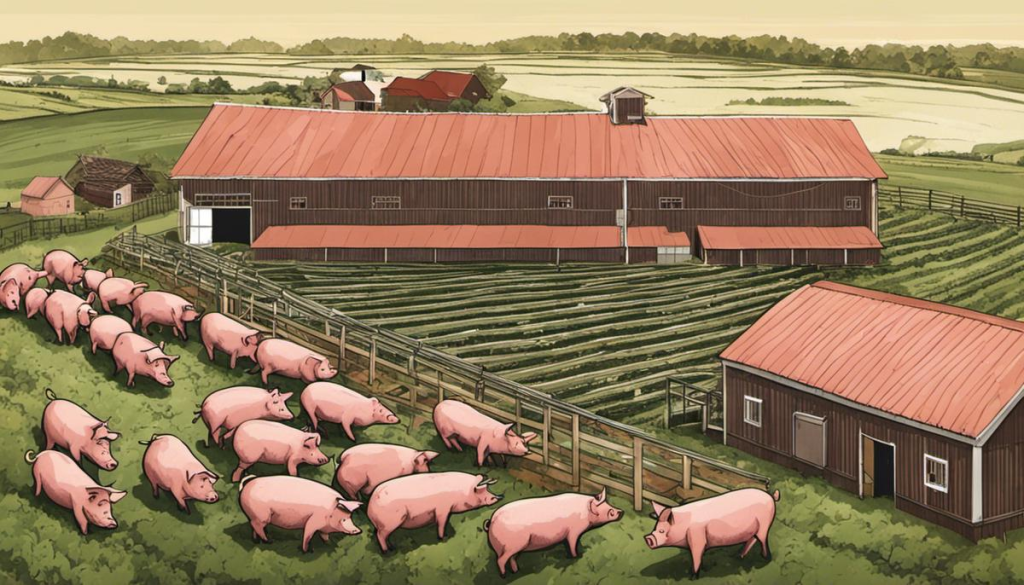
The Pig Farming Industry in the US: Current Status
The Contemporary Statistic of the Pig Farming Industry
In 2021, the U.S. domiciled more than 60 million pigs, and Iowa earned the crown for the leading state with an inventory surpassing 24 million hogs and pigs. A steady increase in the pig population is observed, primarily fueled by both domestic and international upsurges in meat demand. This trend has been boosted further due to modern advancements in pig farming, enhancing productivity while ensuring efficiency in the process.
Geographical Distribution
The top-five hog producing states include Iowa, North Carolina, Minnesota, Illinois, and Indiana. Collectively, these states account for over half of the national pig population. Iowa, in particular, stands out with over 24 million pigs, doubling the hog population of North Carolina, the second-largest pig-producing state. The geographical distribution is influenced by factors such as availability of feed, infrastructure, and climate.
Production Volume: A Key Pillar of the Agricultural Economy
The most recent data indicates the U.S. is the third leading pork producer worldwide, manufacturing over 13 billion pounds of pork annually. The industry contributes significantly to the agricultural economy, creating jobs and supporting local economies in rural areas. According to the National Pork Producers Council, the pork industry is responsible for over 550,000 jobs, and contributes $39 billion to the U.S. gross domestic product.
Microeconomic Factors Influencing the Industry
The pig farming industry is influenced by various microeconomic factors. The cost of inputs, particularly feed, directly affects profitability. Feed prices can be highly volatile due to factors such as crop yields and global commodity prices. The industry is also impacted by disease outbreaks, such as African Swine Fever, that can wipe out large pig populations, disrupt supply chains, and increase costs. Advances in technology can increase efficiency, reducing costs, and increasing production.
Macroeconomic Factors Influencing the Industry
On a macroeconomic scale, trade policies, exchange rates, and tariffs significantly influence the industry. For example, trade disputes with China led to a significant increase in pork prices and a decrease in U.S. exports. Another significant factor is the fluctuation of consumer trends and dietary preferences. For instance, growing interest in plant-based diets could lead to decreased demand for pork, while increases in global protein demand can boost the industry.
Conclusion
Remarkably, the pig farming industry is a significant facet of the U.S. economy, intricately woven into its economic tapestry. Influenced by a myriad of macro and microeconomic factors, the industry’s economic impact remains dynamic and profound, expected to continue its evolution.
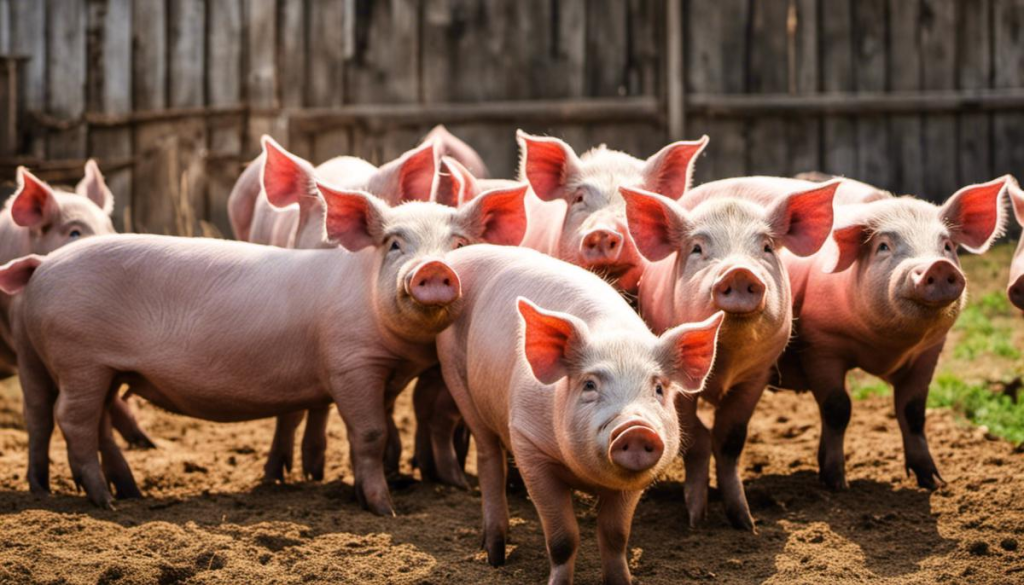
Economic Benefits of Pig Farming
The Economic Influence of Pig Farming
In many countries, including the United States, pig farming is a vital economic pillar, spearheading a multi-billion dollar industry that offers both direct and indirect employment for hundreds of thousands of individuals.
Pig production facilities directly employ numerous people who are intricately involved in farm operations. Breeding, feeding, and overall care of the animals provide jobs for individuals like veterinarians, nutritionists, and operations managers.
Beyond the immediate farm operations, pig farming catalyzes growth in related industries. These range from transportation services responsible for livestock and feed transport, to processing plants that transform hogs into consumable pork and related products, and to retail businesses like grocery stores and restaurants selling pork. This chain reaction generates diversified job opportunities throughout several sectors, truly underscoring the wide-reaching impact of pig farming.
Tax Generation and Industry Fuelling
The pig farming industry significantly contributes to national and local tax revenues. Income tax from employed individuals, taxes on vehicles used in transport, property tax from facility land, and sales tax from pork and other pig-derived products all form part of this tax contribution.
Furthermore, pig farming fuels other industries, such as grain farming and feed production. Pigs typically consume grains like corn, soy, and barley. This stimulates demand for these crops, supporting farmers and associated industries. Similarly, pigs’ nutritional needs prompt the production and sale of specialized pig feed, fostering another related industry.
Furthermore, manure from pig farming is a valuable resource in crop production, acting as a natural fertilizer that replenishes soil nutrients, thereby sustaining the crop production industry.
Role in Export Revenues
Apart from providing domestic economic benefits, pig farming also yields significant export revenues. The U.S, for example, is one of the world’s leading pork exporters. Foreign markets such as Japan, Mexico, and China import U.S. pork in large quantities, contributing substantially to the country’s export earnings.
This export market extends beyond just pork meat. Countries also import live pigs for breeding. Some regions import specific pig byproducts for use in different sectors, such as pharmaceuticals, manufacturing, and cosmetics. This diversifies the export potential of pig farming, enhancing its overall economic impact.
Pig Farming: A Cornerstone of the Economy
The economic relevance of pig farming cannot be overstated. Its multi-faceted contributions to job creation, tax generation, support for related industries, and foreign exchange earnings underscore its importance as an economic cornerstone. The effects of this sector extend beyond the confines of the farms, permeating nearly every aspect of the economy. Thus, it’s crucial to keep this sector thriving for the ongoing vitality of the economy.
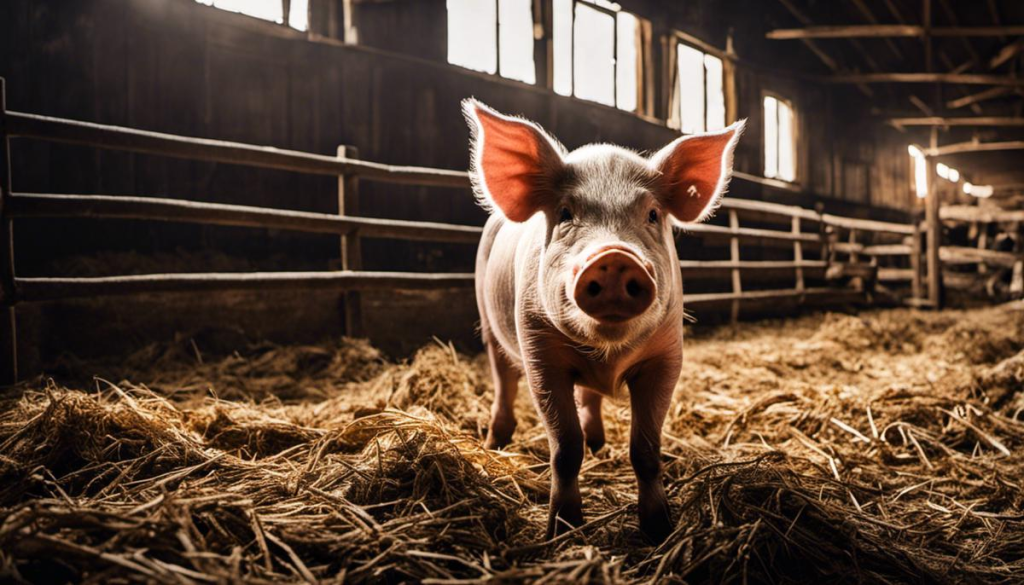
Challenges and Risks Associated with Pig Farming
The Roller Coaster of Pig Farming Market
Riding the tidal wave of the pig farming economy are the constant market fluctuations. The cost of pork tends to be volatile, influenced by a myriad of factors including international demand, the price of feed, and alterations in supply. These market tremors can severely impact farmers, for whom pig farming often represents a considerable portion of their income. Access to up-to-the-minute market data becomes essential, equipping farmers with the foresight needed to navigate effectively through the ebb and flow of supply and demand, ensuring their economic survival.
Disease Outbreaks: A Major Economic Impact
The outbreak of diseases among pigs is another significant risk factor with extensive economic consequences. Diseases like African Swine Fever and Porcine Reproductive and Respiratory Syndrome are highly contagious and can quickly wipe out entire herds, resulting in substantial financial losses for farmers. Disease outbreaks not only lead to the culling of infected animals but also disrupt international trade relations, as countries ban imports from affected regions to avoid the spread of disease.
Environmental Sustainability and Animal Welfare
Maintaining environmentally sustainable farming practices and addressing matters of animal welfare are other challenges linked to pig farming. The sector has faced continuous scrutiny due to the high levels of greenhouse gases it produces and the potential for water pollution from pig waste. Farmers may need to invest in advanced systems to manage waste efficiently, leading to increased production costs. Additionally, as consumers become more aware of animal welfare issues, farmers must balance the economic imperative of high production rates with the societal demand for ethical treatment of animals.
Regulatory Impacts
Pig farming operations are heavily regulated by agencies such as the Environmental Protection Agency and the US Department of Agriculture. These regulations are designed to ensure food safety, protect public health, and maintain animal welfare standards. Non-compliance could lead to heavy fines and other penalties, adding further financial pressure on farmers. In addition, the industry is often subject to international regulations and trade agreements that can either open or restrict market access, impacting farmers’ ability to sell their products at a profit.
Potential Risks and Prospects for the Pig Farming Industry
When contemplating the future of pig farming, several uncertainties come to the forefront. These encompass the prospects of increased regulatory measures, a societal demand for sustainable and humane farming methods, and the interminable threat of disease outbreaks. Furthermore, the rise of lab-grown meat and plant-based alternatives could further challenge this traditional farming sector, influencing the demand for conventionally reared pork. Nevertheless, amidst these potential challenges, there are opportunities presented by technological advancements that have the potential to enhance efficiency, uplift animal welfare, and lessen environmental harm, thereby reinforcing the economic sustainability of the pig farming industry.
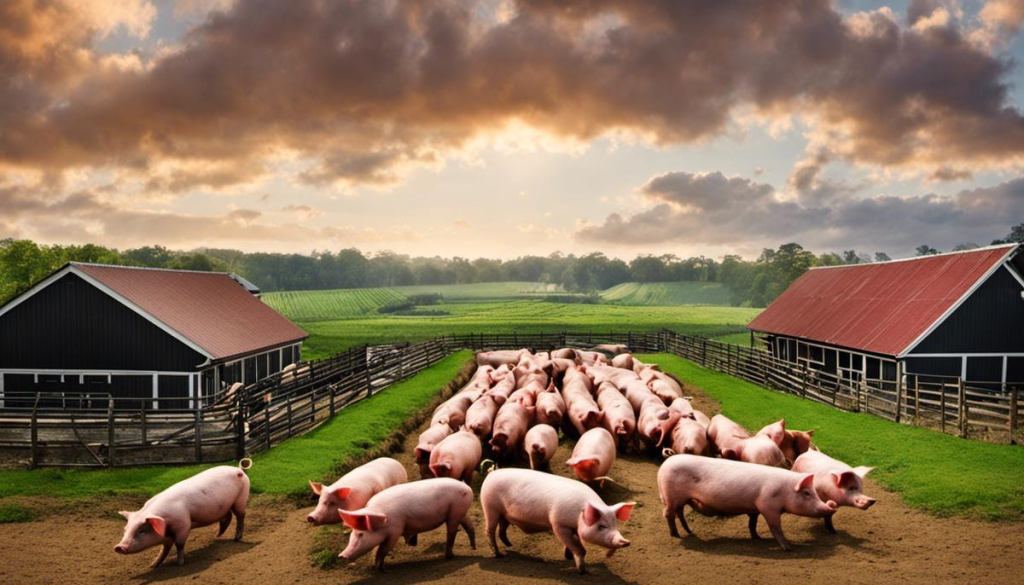
Future Perspectives: The Economic Impact of Pig Farming
Implications of Technology and Pig Farming’s Economic Projections
In the foreseeable future, technological progress is anticipated to have a substantial impact on pig farming’s economic landscape. Technological breakthroughs such as precision farming, the use of Internet of Things (IoT) in pig farming, and gene editing tools like CRISPR, are all set to restructure the sector. For instance, precision farming by leveraging technology such as drones, sensors, and GPS for monitoring and optimizing livestock health and productivity could drastically lower costs and bolster yields.
With the advent of IoT in pig farming, the industry sees immense promise. IoT devices can be used to monitor pigs’ vital signs and behaviors, allowing farmers to detect diseases as early as possible to maintain optimal growth conditions. The application of such technology could drastically reduce losses due to disease and stress, fostering a healthier, more productive pig farming economy.
Moving onto the field of genetics, we expect that creating new pig breeds with enhanced genetic traits will boost productivity and resilience, thereby spurring economic growth. The CRISPR gene-editing tool is already being harnessed to engineer pig breeds that exhibit more resistance to diseases, which in turn considerably diminishes the cost of health management.
Future Projections: Environmental Impact and Sustainability
Beyond these bright prospects, the pig farming industry also faces mounting pressure from environmental concerns. The high emission of greenhouse gases, deforestation driven by feed production, and the heavy use of antibiotics are some of the environmental challenges linked to pig farming. Acknowledging these implications, new strategies for sustainable pig farming are emerging, fundamentally changing the industry’s economic landscape.
One such strategy is circular farming, a system where waste products are recycled within the farm to limit the environmental footprint and reduce costs. Another significant development is the use of alternative feed sources, such as insects and seaweed, which can provide nutrients while reducing the pressure on land and sea resources.
Governmental policies targeting the reduction of greenhouse gas emissions and constraints to an antibiotic-free production are also expected to shape the future economics of the pig industry. Compliance with such regulations might require substantial investments, leading to a potential shift in the market structure.
Future Projections: Market Trends
In terms of market trends, there is growing demand for animal welfare-friendly products. This push towards ethical consumption presents both a challenge and an opportunity for pig farming. On one hand, achieving higher animal welfare standards can imply an increase in production costs. On the other hand, it may allow farmers to charge premium prices, leading to potential growth in this niche market.
As a result of all these factors, the future economic impact of pig farming is predicted to be profound, characterized by increased productivity, higher sustainability standards, and evolving market demands. Through a combination of technological advancements, innovative farming practices, and shifting market trends, the industry has the potential to lead sustainable economic growth and development.
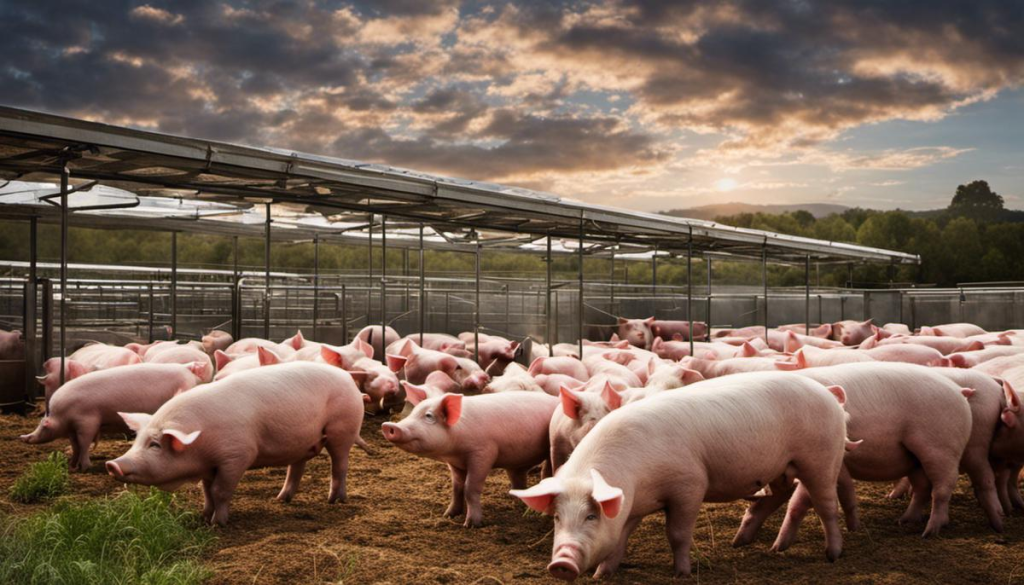
The future of the pig farming industry remains a crucial concern as it continues to underpin many aspects of the US economy. The industry’s sustainability hinges on resilience, innovation, and adapting to future trends and challenges. Recognizing the industry’s past, understanding its present intricacies, and being prepared for future changes is key to maintaining its significant economic contributions. This comprehensive examination of pig farming in the US reminds us of the industry’s integral role and invites stakeholders to ensure its sustained economic impact.